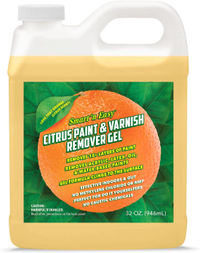How do you remove paint naturally? These eco-friendly buys and homemade paint removers are the solution
This is how natural paint removers can be used safely for every surface, according to experts

Natural paint removers for every surface allow you to tidy up DIY mistakes you may have made without the need for using chemical paint strippers which are particularly harsh.
Whether you've painted over the light switches or plug sockets while trying out the latest on-trend paint ideas, or are prepping for an upcycling project, there are plenty of times you'll need to remove paint on your DIY journey.
'Paint is made to adhere to a surface with longevity being the aim, because of this it is obviously not an easy task to remove paint from surfaces, particularly finishes such as gloss and eggshell,' explains Michael Rolland, DIY expert and MD of The Paint Shed.
'There are paint strippers on the market intended to remove paint, but the issue with some of these are that they can be harmful, particularly when inhaled,' he continues. 'This leads DIYers to search for natural alternatives that are less dangerous for amateurs who may be without the proper protective gear.'
If you're looking for an alternative for a healthier home, here's what you need to know.
Why should I use natural paint removers?
So how can chemical paint strippers be harmful? 'Chemical paint strippers, and the liquid forms especially, come with a range of dangers such as respiratory system damage, skin disease, internal organ damage and brain and nervous system damage, not to mention that most chemical paint strippers are highly flammable too, putting your home at risk,' Michael from the Paint Shed explains. 'It is best that these products are only used by professional painters and decorators.'
'As well as being a danger to health, these paint strippers are also bad for the environment. Most of the chemical paint strippers contain high volumes of VOC - Volatile Organic Compounds - which have been proven to react with oxygen and cause damage to the ozone layer.'
'Luckily, there are less harmful paint strippers on the market that contain more natural materials and, although these will take longer to work, the reduction of risk and harm to the environment makes them worth it,' Michael adds. It's the same as making sure you buy the best eco paints for your home.
What can I use as a natural paint remover?

1. Soy based gel paint removers
Soy-based paint removers contain methyl soyate, which is a methyl ester distilled from soybean oil. As this solvent is derived from a natural source it is much more sustainable and environmentally friendly than petroleum-based products.
'This type of natural paint stripper is safe to use on wood, concrete, and metal, but not recommended for plastic surfaces such as UPVC and laminate,' Michael says.
'It comes in a gel format and is effective at removing paint from the listed surface type, but it will take longer than chemical strippers. The longer it is left on the paint the easier it will be to strip.'
2. Citrus-based paint removers
Citrus-based paint strippers, like soy-based ones, work more slowly in removing paint than stronger chemicals, but again are less harmful on health and the environment.
'Citrus-based paint strippers contain terpenes, which are organic compounds derived from plants, usually oranges - hence the name,' says Michael.
'Typically they are safe to use on any painted or varnished surface, and work particularly well on wood, metal, and masonry. Do be sure to check the manufacturer's instructions before application.'
'Although less harmful than the chemical paint strippers, there are still ingredients within citrus-based paint removers that are harmful to the environment, and therefore precaution should be taken to ensure proper disposal,' he adds.

Smart 'n Easy citrus paint and varnish remover gel, Amazon
This citrus-based paint remover has over 1,000 5 star reviews on Amazon.
3. Heat gun
Heat guns are ideal for removing paint from any surface, without the use of chemicals.
They work like hair dryers - a stream or jet of heated air is projected from the front opening of the heat gun, which heats the paint or varnish enough to be scraped off the surface you are trying to strip. However, it's worth noting they're much more high-powered, and can damage your material if not used correctly.
'Heat guns should be held at an angle of approximately 45 degrees and never kept in one place for more than a few seconds, you don’t want to burn the paint,' says Michael.
'As the paint begins to bubble under the heat, move the gun and strip the paint with a scraper, moving across until you have stripped all the paint desired.'

BLACK+DECKER Heat Gun, Amazon
This budget-friendly heat gun is perfect for casual DIYers.

4. Alcohol Paint Strippers
'Alcohol paint strippers are made from a part water-based, part alcohol-based formula, the main active ingredient in which is usually benzyl alcohol,' says Michael. 'This is an organic compound that can be found naturally in plants and essential oils.
'Although less harmful than many paint strippers, like most alcohols, technically there is a hazard when inhaling it.'
'Bartoline TX10 Paint and Varnish stripper has a highly effective non Methylene Chloride formulation, which is non-flammable and is biodegradable,' he continues. This product is water-based, meaning there is minimal evaporation. 'It clings to vertical surfaces meaning no drips, runs or waste. It is suitable for use both indoors, in a well ventilated area, and out, by decorating professionals and novice DIYers. You can use it to remove paint from wood, metal, glass, plaster and concrete.'
How to do it? 'Users of this product should apply a generous coating by brush to the surface to be stripped and leave for approximately 30 minutes,' Michael explains. 'For areas where there are more than five layers, a second coat may be necessary, but once TX10 has penetrated to the substrate, it can be scraped off, leaving the surface clean. The stripped area can then be rubbed down using sandpaper, steel wool or a scrubbing brush.'
5. Ammonia, borax and washing soda
You can also create your own homemade natural paint remover remedies with products you may already have in your kitchen cabinets.
'To make your own paint remover, simply take a dish or vessel and pour in one part ammonia, one part borax (both naturally occurring elements) and one part washing soda,' Michael says. 'Also add a small amount of water. Two tablespoons is perfect for one cup of each ingredient, so scale up/down from there.'
'Stir the mixture together until a paste is formed. Taking a brush, coat the paint with the mixture and let it sit for at least around 10-20 minutes for it to break down the paint. When the time is up, scrub off the paint using steel wool.'
This solution can be used on most surfaces, but do patch test first in a part that is not overly visible.

6. Washing soda, water and flour
You can also use a mixture of washing soda, water and flour to remove paint.
'Take a large vessel and pour four tablespoons of washing soda per one cup of water,' advises Michael. 'Once mixed together, add a tablespoon of flour to the mixture to thicken it. Incorporate the flour completely and add another tablespoon.
'Repeat this process until the mixture has a creamy consistency but is still spreadable.'
He continues: 'Once you’ve made your remover, just coat the target surface with it using a brush or palette knife. Let the coating sit for roughly half an hour before removing it, scraping off any leftover paint as you go.'
This solution can be used on most surfaces, but do patch test first in a part that is not overly visible.
7. Vinegar
While vinegar doesn’t remove paint directly, it does soften paint significantly, making it easier to remove by hand.
'If you’re working on a smaller project, vinegar can be a great way to make the scraping process a lot faster,' says Michael.
'To use vinegar, heat some in a pot and wait for it to boil. Using a brush, apply the vinegar to the surface, and let it rest. Keep testing the paint to see if it has softened. If not, repeat if necessary.'
He adds: 'If you want to strip the paint from a small object, you can also take an old pot and fill it with water and pop it on the hob. Add ¼ of a cup of baking soda in the pot and leave it to incorporate. Make sure not to stir it.
'As the pot reaches a simmer, watching that it doesn’t boil, place whatever object is covered in paint into the pot. If your pot is big enough, you can do multiple objects at a time, but make sure to not let them come into contact with one another or the side of the pot.
'After around 10 minutes, check the items in the pot to see if the paint has been removed. Then leave to dry.'
Be The First To Know
The Livingetc newsletter is your shortcut to the now and the next in home design. Subscribe today to receive a stunning free 200-page book of the best homes from around the world.
Ruth Doherty is a lifestyle journalist based in London. An experienced freelance digital writer and editor, she is known for covering everything from travel and interiors to fashion and beauty. She regularly contributes to Livingetc, Ideal Home and Homes & Gardens, as well as titles like Prima and Red. Outside of work, her biggest loves are endless cups of tea, almond croissants, shopping for clothes she doesn’t need, and booking holidays she does.
-
 How to Thaw a Frozen Pipe — Learn Everything You Need to Know in 5 Minutes With This Guide
How to Thaw a Frozen Pipe — Learn Everything You Need to Know in 5 Minutes With This GuideWinter storm caught you off guard? We asked an expert — just how do you thaw a frozen pipe?
By Hugh Metcalf Published
-
 The 12 Very Best Silk Bedding Pieces — As Our Style Editor Says: 'It's What Dreams Are Made Of!'
The 12 Very Best Silk Bedding Pieces — As Our Style Editor Says: 'It's What Dreams Are Made Of!'Slumber in lustrous luxury with the very best silk bedding sheets, duvets, pillowcases, and more — your sleep score will thank us later
By Julia Demer Published

